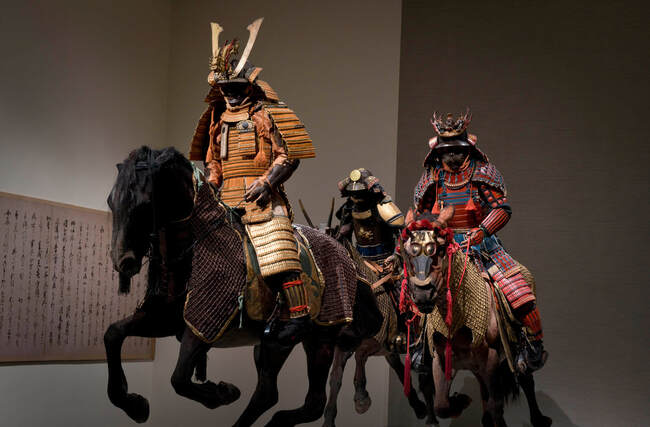|
For much of the thousand years before the late 19th century, Japanese history was marked by civil wars and factional power struggles. In Japan's insular and highly stratified social structure alliances shifted between the Emperor, the Shogun or supreme military commander and the daimyo or powerful landholders. Much of the fighting was carried out by the warrior class, or samurai.
In this society where power was underpinned by military might, martial arts were extremely important. The highly respected samurai developed an elaborate code based on discipline, ritual and symbolism generally referred to as Bushido or The Way of the Warrior. Accordingly, the samurai's armour, weaponry and horse tack developed along lines that combined practical necessity and symbolism. The codification and enforcement of samurai practices and appearance were most pronounced during the Edo period from 1603-1868. This period, in which Edo (present day Tokyo) took over from Kyoto as the centre of power, was the last of several epochs in Japanese history before the country openly embraced Western culture and technology. Despite many subtle variations in material, technique and decoration, Japanese armour changed relatively little over the centuries. It was a lamellar type armour meaning that it was constructed of metal or leather plates or lames laced together in overlapping rows. The Japanese disliked the look of untreated non-precious metals, therefore metal plates were often lacquered or subjected to other aesthetic processes. These lames were interwoven with rows of textile cord or brocade, often silk. Armour was made of many pieces and elements, each with its own particular name, covering most parts of the body. For instance the ensemble of plates protecting the torso was called the do. The thigh protectors were the haidate. A helmet or kabuto protected the head. This typically had horns or blades called kuwagata at the front and a plated neck guard called a shikoro at the back. The face was protected by a mask called a mempo or men gu. This was often lacquered metal or leather covering the face from the eyes down. It was moulded to simulate facial features cast in an angry countenance. The inside of the mempo was often lacquered with red to reflect upon the skin of the wearer thereby enhancing the terrifying visage. A simulated bristling moustache made from animal fur was frequently attached to the mempo. A plated and laced throat protector or yodare kake was attached to the bottom of the mempo. The overall effect of the decorated armour, horned helmet and horrifying face plate was awesome, as indeed it was intended to be. History of Japanese Samurai Kabuto The natural progression of design from the eleventh century of the Japanese Samurai Helmet or Kabuto known as Hoshi Kabuto (helmets with large, high standing, rivet heads), to a steady reduction in size of the rivets, to kabuto with rivets filed flat in the fifteenth century. Early sixteenth century saw the introduction of multi plate helmets frequently referred to as Suji Bachi (Multi-plate helmet of which the rivets are counter sunk, leaving the flanged edges of the plates prominent). Suji directly translates into English as rib or flange. These multi-plate helmets from the five plate head shaped Zunari to as many as two hundred plate helmets in the early seventeenth century that would have surely rocked the traditionalist’s boat, became in vogue. No sooner had they do so than Kabuto adornment and fancy crests known as Maedate and horns known as Kuwagata appeared that caused a major stir on the battle field, and the race was on to see who could produce the most outrageous Kabuto. The seventeenth century was the golden era for the armorers that allowed free reign of design expression and every conceivable object, foreign influences Namban kabuto and the extraordinary Kawari Kabuto Particularly those auspicious from dragons to bats and conch shells attracted the eye of the armorer and our now ever receptive fashion conscious Samurai. There are certain theories regarding just how this fashion trend actually evolved none of which have actually been proven factual. Economics and the fact the Japanese Master craftsmen realized that their fine quality workmanship was walking advertising, soon listened to the undercurrent of chatter and with unquestionable certainty knew this market trend was going to become more in vogue The Kabuto is the crown upon the Samurai’s Armor. The pinnacle of technical and artistic skill and must be considered the central focus of the entire armor. Samurai Kabuto were considered of prime importance and thus the armorer lavished his greatest attentions upon it, much to the delight of today's discerning collectors.
1 Comment
|
AuthorMonte Schumacher is the owner of Shogun Art. For the past 25 years he has been considered one of the world's most knowledgeable experts in authentic Japanese Samurai Armor. Archives
March 2022
Categories |


